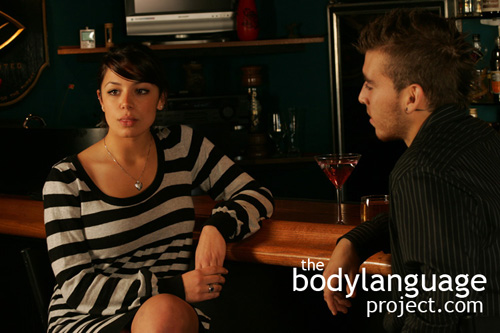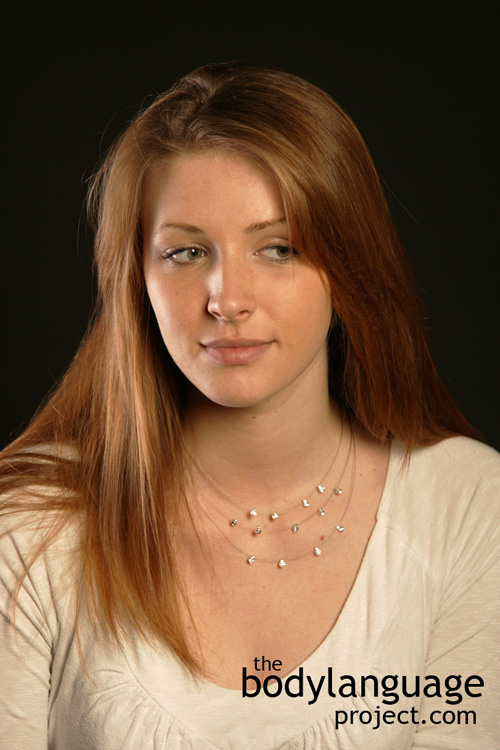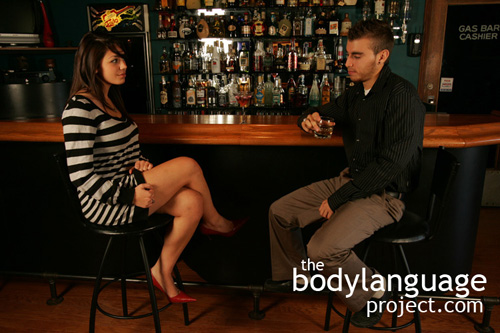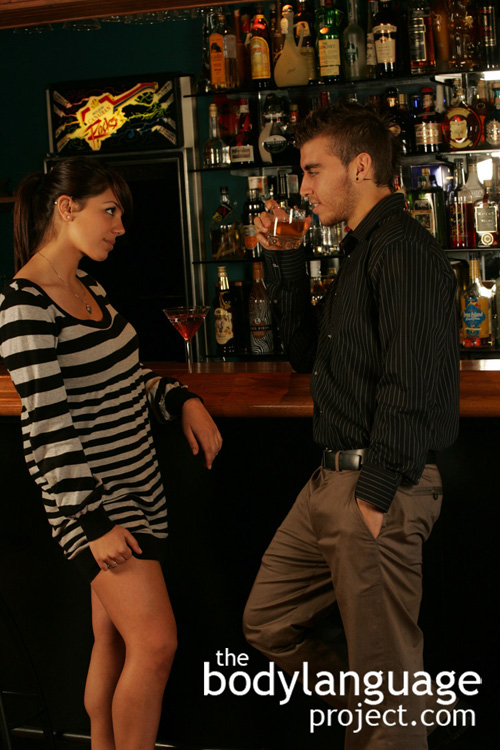Body Language Of The Uneven Smile Or Lopsided Smile
Synonym(s): Apologetic Smile, Lopsided Smile.
Description: An uneven smile is on where the left and right side of the mouth do not match. One side of the face is pulled up and is smiling and the other side is not or may be downturned or frowning.
In One Sentence: The uneven smile indicates the presence of conflicting emotions.
How To Use it: Use the uneven smile when you want to show others that you can’t fully commit to contentment. You might flash the uneven smile when you acknowledge the smile of another person, but don’t particularly feel happy yourself. Also, when joking around or being sarcastic, the uneven smile can be used to show other people that you are not to be taken seriously.
Context: General.
Verbal Translation: “Wish I hadn’t made that mistake”, “That seems odd”, “I’m pulling your leg, see how I did that!” “I’ve got myself in a twist.” “On one side, “yes” and on the other “better not.”
Variant: See Smiling, Fear Smile, Friendly Smile, Frown (the) or Downturned Smile, Honest Smile or Duchenne Smile, Jaw Drop Smile, Nervous Smile, Polite Smile (the), Uneven Smile Or Lopsided Smile, Upper Lip Smile, Artificial Smile or Fake Smile, Nervous Smile, Honest Smile or Duchenne Smile, Contempt Facial Expression.
Cue In Action: When Bob took Bill’s stapler from his desk he made a lopsided smile in Brenda’s direction – they both knew that Bob was going to lose it on her if it was missing.
Meaning and/or Motivation: The uneven smile depicts a frame of mind in which opposite emotions are present such as uncertainty, tongue-in-cheek humour and sarcasm. The uneven smile is coupled with cheeky humour amongst friends and also during sarcasm.
Cue Cluster: A lopsided smile can appear in unison with upturned palms and shoulder shrugs.
Body Language Category: Leaked or involuntary body language, Microgestures.
Resources:
Abel, Ernest L. and Michael L. Kruger. Smile Intensity in Photographs Predicts Longevity. Psychological Science. 2010. 21(4): 542-544.
Colonnesi, Cristina; Susan M. Bogels; Wieke de Vente and Mirjana Majdandzic. What Coy Smiles Say About Positive Shyness in Early Infancy. Infancy. 2013. 18(2): 202–220. ISSN: 1525-0008 print / 1532-7078 online
DOI: 10.1111/j.1532-7078.2012.00117.x
http://bodylanguageproject.com/articles/nonverbal-meaning-coy-smiles-infants/
Fairbairn, Catharine E.; Michael A. Sayette; Odd O. Aalen and Arnoldo Frigessi. Alcohol and Emotional Contagion: An Examination of the Spreading of Smiles in Male and Female Drinking Groups. Clinical Psychological Science. 2014. DOI: 2167702614548892
http://bodylanguageproject.com/articles/alcohol-social-lubricant-male-smiles/
Gueguen, Nicolas. Weather and Smiling Contagion: A Quasi Experiment With the Smiling Sunshine. Journal of Nonverbal Behavior. 2013. 37:51–55. DOI 10.1007/s10919-012-0140-y
http://bodylanguageproject.com/articles/weather-smile-not-contagion-smile-linked-weather-conditions/
Golle, Jessika; Fred W.; Mast and Janek S. Lobmaier. Something to Smile About: The Interrelationship Between Attractiveness and Emotional Expression. Cognition and Emotion, 2014. 28:2: 298-310. DOI: 10.1080/02699931.2013.817383.
http://bodylanguageproject.com/articles/smiles-arent-just-cameras/
Guéguen, N. The Effect Of A Woman’s Smile On Men’s Courtship Behavior. Social Behavior and Personality. 2008. 36(9): 1233-1236.
http://bodylanguageproject.com/articles/how-women-can-use-a-simple-smile-to-attract-men/
Guéguen, N., & Fischer-Lokou, J. (2004). Hitchhiker’s Smiles And Receipt Of Help. Psychological Reports. 94: 756-760.
Gosselin, Pierre; Reem Maassarani; Alastair Younger and Mélanie Perron. Children’s Deliberate Control of Facial Action Units Involved in Sad and Happy Expressions. Journal of Nonverbal Behaviour. 2011. 35:225–242. DOI 10.1007/s10919-011-0110-9.
http://bodylanguageproject.com/articles/childrens-control-facial-actions-improve-age-create-accurate-emotional-expressions/
Gunnery, Sarah D.; Judith A. Hall and Mollie A. Ruben. The Deliberate Duchenne Smile: Individual Differences in Expressive Control. Journal of Nonverbal Behavior. 2013. 37:29–41. DOI 10.1007/s10919-012-0139-4
http://bodylanguageproject.com/articles/can-probably-fake-honest-smile-deliberate-duchenne-smile/
Hertenstein, Matthew J.; Carrie A. Hansel; Alissa M. Butts and Sarah N. Hile. Smile Intensity In Photographs Predicts Divorce Later In Life. Motiv Emot. 2009; 33:99-105
DOI 10.1007/s11031-009-9124-6
http://bodylanguageproject.com/articles/small-smiles-predicts-divorce/
Harker, L., & Keltner, D. (2001). Expressions Of Positive Emotion In Women’s College Yearbook Pictures And Their Relationship To Personality And Life Outcomes Across Adulthood. Journal of Personality and Social Psychology, 80(1), 112–124. doi: 10.1037/0022-3514.80.1.112.
Krumhuber, E., Manstead, A., & Kappas, A. Temporal Aspects of Facial Displays in Person and Expression Perception: The Effects of Smile Dynamics, Head-tilt, and Gender. Journal of Nonverbal Behavior. 2007. 31(1), 39-56.
http://bodylanguageproject.com/articles/slow-onset-smile-best/
Krause, Michael W. and Teh-Way David Chen. A Winning Smile? Smile Intensity, Physical Dominance, and Fighter Performance. Emotion. 2013. 13 (2): 270–279. DOI: 10.1037/a0030745
http://bodylanguageproject.com/articles/smile-lose-smile-intensity-predicts-fighting-ability
Krumhuber, Eva G.; Manstead and Antony S. R. Can Duchenne smiles be feigned? New evidence on felt and false smiles. Emotion. 2009. 9 (6): 807-820.
http://bodylanguageproject.com/articles/can-fake-real-smile-practice/
Krumhuber, Eva; Antony S. R.; Manstead; and Arvid Kappas. Temporal Aspects of Facial Displays in Person and Expression Perception: The Effects of Smile Dynamics, Head-tilt, and Gender. Journal Nonverbal Behavior. 2007; 31: 39-56.
DOI 10.1007/s10919-006-0019-x
http://bodylanguageproject.com/articles/head-tilt-and-slow-onset-smile-nonverbals-trust-attraction-dominance-and-flirting-a-brief-report/
Kahlbaugh, Patricia ; Haviland, Jeannette. Nonverbal communication between parents and adolescents: A study of approach and avoidance behaviors. Journal of Nonverbal Behavior. 1994 18(1): 91-113.
Labroo, Aparna A.; Anirban Mukhopadhyay; Ping Dong. Not Always the Best Medicine: Why Frequent Smiling Can Reduce Wellbeing. Journal of Experimental Social Psychology. 2014. 53:156-162.
http://bodylanguageproject.com/articles/why-too-much-smiling-can-be-bad-for-you/
Lockard, J. S., McVittie, R. I., & Isaac, L. M. (1977). Functional Significance Of The Affiliative Smile. Bulletin of the Psychonomic Society, 9, 367-370.
Matsumoto, David. Scalar Ratings Of Contempt Expressions Journal of Nonverbal Behavior. 2005. 29(2): 91-104.
Navarro, Joe. 2008. What Every BODY is Saying: An Ex-FBI Agent’s Guide to Speed-Reading People. William Morrow Paperbacks.
Navarro, Joe. A four-domain model for detecting deception: an alternative paradigm for interviewing. The FBI Law Enforcement Bulletin. 2003. 72(6): 19(6).
Okubo, Matia; Akihiro, Kobayashi and Kenta Ishikawa. A Fake Smile Thwarts Cheater Detection. Journal of Nonverbal Behaviour. 2012. 36:217–225. DOI 10.1007/s10919-012-0134-9
http://bodylanguageproject.com/articles/fake-till-make-cheaters-fake-smile-make-lies-difficult-detect/
Reissland, Nadja; Brian Francis, James Mason, Karen Lincoln. Do Facial Expressions Develop before Birth? August 2011. 6(8): e24081. doi:10.1371/journal.pone.0024081.g001
http://bodylanguageproject.com/articles/the-cry-and-laugh-face-in-the-human-fetus/
Reed, Lawrence Ian; Katharine N. Zeglen and Karen L. Schmidt. Facial Expressions as Honest Signals of Cooperative Intent in a One-Shot Anonymous Prisoner’s Dilemma Game. Evolution and Human Behavior. 2012. 33: 200-209.
http://bodylanguageproject.com/articles/facial-expressions-honest-signals-smiling-contempt-predict-cooperation-defection/
Seder, J. Patrick and Shigehiro Oishi. Intensity of Smiling in Facebook Photos Predicts Future Life Satisfaction. Social Psychological and Personality Science. 2012. 3(4): 407-413.
http://bodylanguageproject.com/articles/facebook-smile-predicts-life-satisfaction/
Samuele Centorrino, Elodie Djemai, Astrid Hopfensitz, Manfred Milinski, Paul Seabright. Honest Signaling in Trust Interactions: Smiles Rated as Genuine Induce Trust and Signal Higher Earning Opportunities. Evolution and Human Behavior DOI:
dx.doi.org/10.1016/j.evolhumbehav.2014.08.001.
http://bodylanguageproject.com/articles/smile-great-gain-smiling-key-negotiation/
Teixeira Fiquer, Juliana; Paulo Sérgio Boggio and Clarice Gorenstein. Talking Bodies: Nonverbal Behavior in the Assessment of Depression Severity. Journal of Affective Disorders. 2013. 150: 1114-1119.
http://bodylanguageproject.com/articles/using-nonverbal-behaviour-to-assess-depression-severity/
Tidd, K., & Lockard, J. (1978). Monetary Significance Of The Affiliative Smile: A Case For Reciprocal Altruism. Bulletin of the Psychonomic Society, 11, 344-346.
Underwood, M. K.. Glares of Contempt, Eye Rolls of Disgust and Turning Away to Exclude: Non-Verbal Forms of Social Aggression among Girls. Feminism & Psychology. 2004 14(3): 371-375
Vazire, S., Naumann, L.P., Rentfrow, P. J., and Gosling, S. D. (2009). Smiling reflects different emotions in men and women. Behavioral and Brain Sciences, 32:5, 403–405.
http://bodylanguageproject.com/articles/smiling-reflects-different-emotions-men-women/
Vigil, J. M. (2009). A socio-relational framework of sex differences in the expression of emotion. Behavioral and Brain Sciences, 32, 375–428.
Walsh, D. G., & Hewitt, J. (1985). Giving Men The Come-On: Effect Of Eye Contact And Smiling In A Bar Environment. Perceptual and Motor Skills, 61, 873-874.










